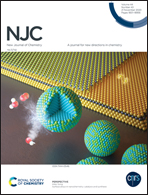Artificial co-enzyme based on carbamoyl-modified viologen derivative cation radical for formate dehydrogenase in the catalytic CO2 reduction to formate
Abstract
Formate dehydrogenase (CbFDH) from Candida boidinii is a useful biocatalyst for CO2 reduction to formate in the photoredox system, and consists of a visible-light sensitizer and an electron mediator. The electron mediator, single-electron reduced 4,4′-bipyridinium salts (4,4′-BPs) represented by methylviologen act as the co-enzyme for CbFDH in the CO2 reduction to formate. Considering that the single-electron reduced 4,4′- or 2,2′-BPs activate the CbFDH-mediated CO2 reduction to formate, the architecture of the effective co-enzyme based on the chemical modification of BP is useful for the development of the catalytic reduction of CO2 to formate with CbFDH. NAD+ has a carbamoyl group or nicotinamide moiety, which can form hydrogen bonds with some amino residues in CbFDH. Thus, we predicted that the affinity of 4,4′-BP for CbFDH could be improved by introducing a carbamoyl group or nicotinamide moiety into 4,4′-BP. In this work, the interaction between the single-electron reduced 1-carbamoylmethyl-1′-methyl-4,4′-bipyridinium salt, 1,1′-dicarbamoylmethyl-4,4′-bipyridinium salt and 1-nicotinamidethyl-1′-methyl-4,4′-bipyridinium salt and CbFDH in the CO2 reduction to formate is elucidated by enzymatic kinetic analysis, the docking simulation and density functional theory calculation.



 Please wait while we load your content...
Please wait while we load your content...